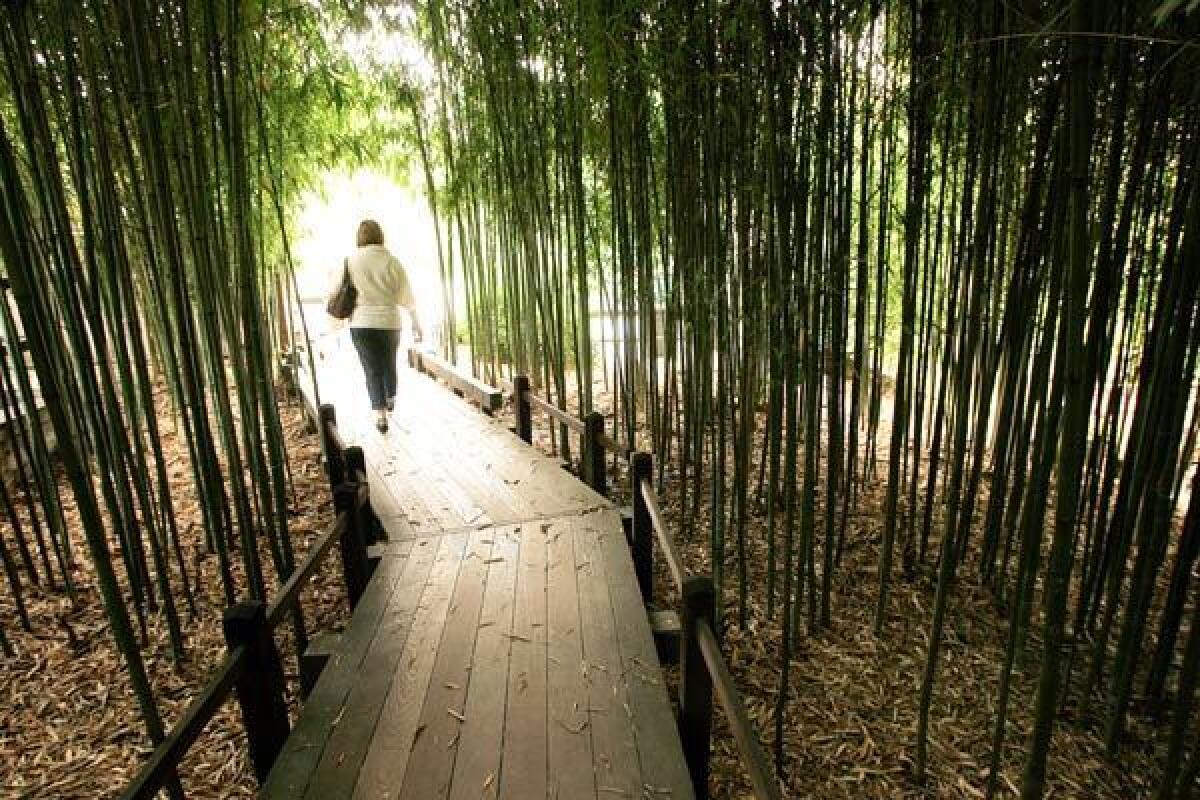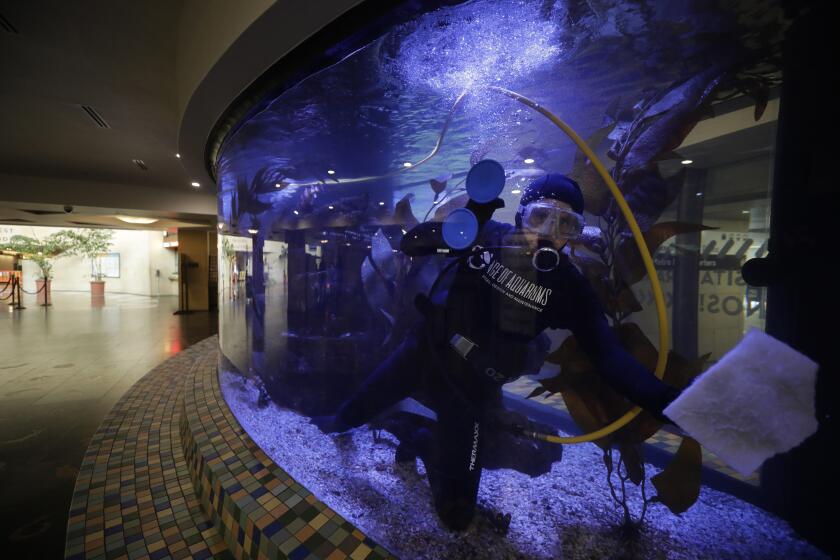Some outdoor museums may open, Newsom says, but what’s an outdoor museum?

Outdoor museums are among the places that Gov. Gavin Newsom said Tuesday have the green light to reopen in some regions, but that statement has created confusion is places such as Los Angeles County, which is giving museums, outdoor and otherwise, a red light for now.
L.A. County has been the area hardest hit by the pandemic in California, with more than 35,000 COVID-19 cases and more than 1,700 deaths as of Thursday, so outdoor museums are not allowed to open just yet.
“We will now work to see what’s feasible and what makes sense,” L.A. County Public Health Director Barbara Ferrer said during Wednesday’s press briefing, offering no specific timeline. “We may go a little slower than the state and we ask that you have patience.”
Gov. Newsom’s latest guidelines for outdoor museums apply as well to open-air galleries, botanical gardens and outdoor exhibition spaces. That does not include zoos, amusement parks and indoor spaces at museums and galleries, including exhibit halls, gift shops and cafes. The guidelines cover the training and screening of staff and interaction with visitors, as well as cleaning and disinfecting protocols.
Neither the state nor the county has delineated what constitutes an outdoor museum, compounding the confusion. Individual institutions make the call.
“The different venues have to make the decision based on if they feel they can accommodate people safely,” said the Huntington Library, Art Museum and Botanical Gardens’ vice president of communications and marketing, Susan Turner-Lowe.
The coronavirus crisis prompted some museums and the L.A. Phil to dip into their endowments. But what does that really mean, and how does that work?
The Huntington decided it is an outdoor museum and is assembling a plan to keep staff and visitors safe. When it’s allowed, it will reopen outdoor spaces across most of its 130 acres in San Marino. It won’t open “high-touch” outdoor areas such as the children’s garden, which has interactive components, or an immersive science learning environment created for middle school kids.
Another change: The Huntington will institute a timed ticketing system, in which guests will pay for reserved slots in advance, so there won’t be any in-person exchange of money. Visitors will be required to wear face coverings, given hand sanitizer and asked to maintain social distance. The Huntington also is tweaking the flow of foot traffic so pathways don’t become congested.
“The Huntington is a big property and it’s complicated,” Turner-Lowe said. “But we’re working through it, reconfiguring on the fly but in a thoughtful manner that provides a safe and enjoyable experience.”
Despite its central garden, cactus garden and two sculpture gardens, the Getty Center does not consider itself an outdoor museum, said J. Paul Getty Trust vice president of communications Lisa Lapin. “While the Getty Center and Getty Villa do have outdoor areas and gardens to be enjoyed,” she said, “many must be accessed through indoor spaces. Our collections are housed indoors.”
The Getty has had a task force in place since early February that meets twice weekly to discuss operations. Initially it focused on closing the Getty sites and transitioning staff to working from home; now it’s concentrating on how best to reopen. “We will reopen both our outdoor and indoor spaces simultaneously to visitors when it is deemed safe to do so,” Lapin said.
L.A.’s train station is empty and “it’s eerie,” says the man who feeds the fish. But it’s also “a real escape from what’s going on in the outside world.”
The Norton Simon Museum in Pasadena doesn’t consider itself an outdoor museum. It has an outdoor sculpture garden that it considers an integral part of the visitor experience, but guests must pass through the indoor lobby to get to it.
Some institutions are known for their outdoor exhibits but don’t consider themselves outdoor museums. The Natural History Museum of Los Angeles County and the Museum at the La Brea Tar Pits, said director Lori Bettison-Varga, are “indoor and outdoor experiences engaging with natural history, nature and culture.” The outdoor areas they’re nestled in — Exposition Park and Hancock Park, respectively — are open to the public, but neither institution is an outdoor museum, Bettison-Varga said, so both remain closed.
The Los Angeles County Museum of Art also said it is not an outdoor museum, but its open-air, interactive sculptural installations — Chris Burden’s “Urban Light” and Michael Heizer’s “Levitated Mass” — are still open to the public, albeit with social distancing signage.
The downtown L.A. gallery Hauser & Wirth is composed of multiple spaces, including an open-air courtyard that exhibits sculpture, four indoor galleries, an indoor-outdoor restaurant, a bookstore and a garden with live chickens. But it’s considering those spaces as one entity that is decidedly not an outdoor gallery.
“Because these spaces are all connected, we have to reopen them carefully and in gradual phases,” said gallery partner Stacen Berg. Hauser & Wirth anticipates reopening indoor galleries first, in June, by appointment only so as to maintain social distance. The reopening of outdoor spaces, in tandem with the restaurant, would follow, Berg said.
Descanso Gardens in La Cañada Flintridge does consider itself an outdoor museum — but L.A. County, which owns the land it’s on, does not. The county considers it a park, even though it’s an accredited museum, so it would have been allowed to stay open throughout the pandemic; it just chose not to.
“We decided to close because spring is our busiest time — so many people were coming — and we needed to take a breath and make sure we could operate safely for staff and visitors,” said museum spokeswoman Jennifer Errico.
Now with a plan in place, Descanso will reopen Saturday with timed ticketing, paid online in advance. It will operate at 30% capacity, though it will stay open two hours later, until 7 p.m., to accommodate more people. Visitors will be required to wear masks and maintain social distance, among other protocols.
“It won’t be the same as before,” Errico said. “The Boddy House will be closed, so will the art gallery. The railroad and restaurant will be closed. But the rose gardens are spectacular now and so is the California native garden — poppies everywhere! — so we’re super excited.”
Sculptures commemorating plagues were common in Europe. Our art critic suggests America could build its own, and Trump provides inspiration for where.
More to Read
The biggest entertainment stories
Get our big stories about Hollywood, film, television, music, arts, culture and more right in your inbox as soon as they publish.
You may occasionally receive promotional content from the Los Angeles Times.














